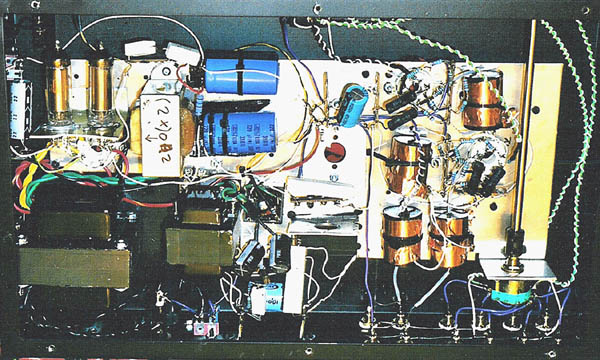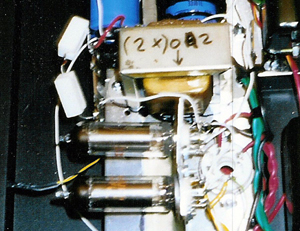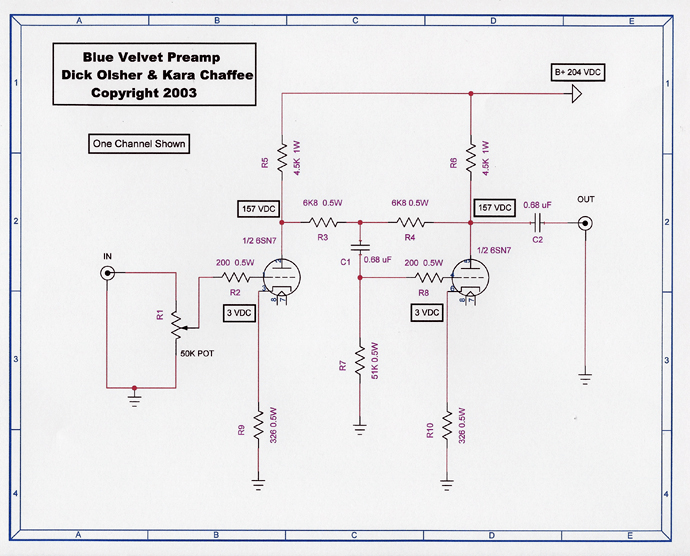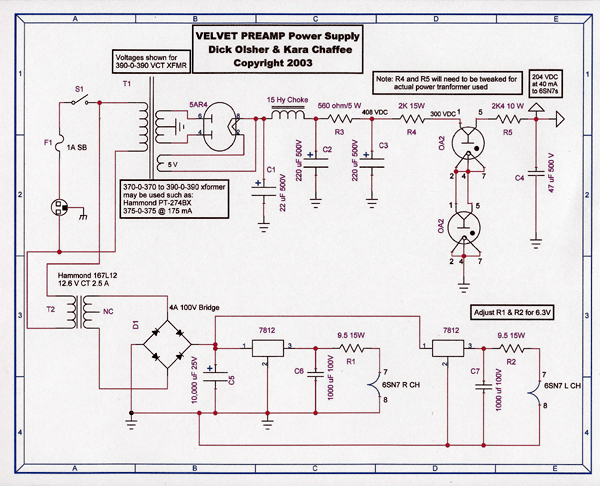|
The Blue Velvet Line Preamplifier Design by Dick Olsher and Kara Chaffee Article by Dick Olsher
Intro Why another line preamplifier? There is certainly no shortage of commercial models, in a variety of flavors and price points, to satisfy even the most jaded of audiophile palettes. But then my vision for the Blue Velvet (BV) was rather unusual. The BV was borne in a creative spark some two years ago as a showcase for the venerable 6SN7 dual triode, an octal with a reputation for being a great driver tube. My goal was to create the ultimate vehicle for the evaluation and enjoyment of vintage 6SN7s such as the RCA VT-231. Keep in mind (to be perfectly blunt about it) that I was at the time suffering from 6SN7 mania, scouring tube re-sellers and Ebay for classic 6SN7s. I finally had the tubes, now I needed just the right preamplifier to fully coax their magic. The BV had to meet the following criteria:
The first two criteria are based on the desire to keep things fairly simple and to allow the 6SN7 to dominate the sonic signature of the preamp. As in all things in life, choices revolve around simplicity versus complexity. My approach was to complicate the power supply to the extent necessary, while maintaining a simple signal path. Number 3 simply reflects the fact that tube rectification is more musical than a solid-state equivalent circuit, and that vintage tube sound is really impossible without it. Regarding #4, gas tube regulation is ideally suited for a preamp application where current swings are fairly low and, as an added bonus, the circuitry is simple to implement. I like the idea of having a reference DC voltage for B+ and reasonable immunity from AC mains voltage fluctuations. And besides, these gas discharge tubes are so cool. Criterion #5 follows logically on the heels of #4, as it is important to stabilize filament emission. Another critical factor is control over the initial inrush of filament current due to the low resistance of a cold filament wire. You’ve no doubt seen preamplifier tubes light up like light bulbs after power is turned on. The inrush current may be a factor of five higher than the nominal filament current and that surge may well contribute to a shortened filament life. After the filament heats up, its resistance increases and the current drops to its nominal value. A controlled heating cycle for the filament was sought to protect one’s investment and extend a premium 6SN7’s life span. I was determined to get every “drop” of good sound I could out of my expensive bottles. The power supply is the engine that makes for major performance differences between competing models. If you want Ferrari-like headroom and dynamics, start with an excellent power transformer with good regulation and follow it up with sufficient filtration to minimize hum and noise. The power supply shown in the schematic below is oversized. Its power transformer/rectifier section could easily service a small tube power amplifier. This is by design., and in keeping with our philosophy that an amplifier grade power transformer lays the foundation for an excellent preamplifier. That brings us up to #7. Praxis has shown that a 6SN7 sounds its harmonic best when driven fairly hot. Of course, taken close to its thermal loading limit, any tube’s life time would be severely shortened. A happy middle ground was sought at 50% of the thermal rating to balance sonics against life time. Criteria #8 and #9 should be considered together, as a package deal, because they play interactive roles in the design of the gain stage. A low output impedance is important in driving load interconnect runs without bandwidth losses. But it’s difficult to obtain both high gain and low output impedance in a two-stage circuit. The 12-dB criterion makes it possible to achieve the design goals while accommodating most line source inputs. As part of the design process I evaluated several circuit topologies using John Broskie’ s Tube CAD program (http://www.glass-ware.com/tubecad/). It’s an excellent tool for scoping out the performance envelope of a particular tube in a variety of gain stages and for zeroing in on the most promising options without actually having to prototype a large number of alternatives. Circuit Evolution The most interesting option, and the one chosen for further investigation was a compound amplifier consisting of a grounded cathode stage cascaded to an anode follower. It easily meets the design goals with the additional advantages of excellent linearity, minimal distortion, and balanced current draw from the power supply. The anode follower is similar in action to that of a cathode follower, but allows for a gain greater than one. Much of the anode follower’s output is returned to the grid via resistor R4. That’s local feeback to the tune of about 15 dB which linearizes the compound amplifier and reduces output impedance to around 400 ohms. The first BV prototype was built up using a 6X4 tube rectifier, a pair of OB2 gas regulators, and a Hammond 270DAX power transformer. It was clear from the outset that the design had much promise, but it was far too noisy to qualify for prime time. Enter deHavilland Audio’s Kara Chaffee. Kara graciously agreed to collaborate on the BV project in order to refine the circuitry and improve the signal to noise ratio, and it is due to her hard work and exceptional design expertise that the BV reached its full potential. That explains why the BV prototype was built up on a deHavilland preamplifier chassis using a proprietary power transformer. But let me make this perfectly clear: deHavilland does NOT offer a commercial version of the BV kit, nor does it offer any kit parts for sale. So, please don’t bug the nice folks at deHavilland about kit parts. In fact, no boards or custom parts are presently available. After fine tuning various circuit values, the circuit quieted down, but not enough to satisfy Kara. Gas regulator tubes are notoriously noisy creatures, and since they shunt the tail-end of the power supply, noise is coupled directly to the anodes of the 6SN7. Kara’s preferred solution was the addition of a plate decoupling circuit (R5/C4 in the power supply schematic) to better isolate the power supply from the BV outputs. This second prototype was certainly much quieter but its dynamic authority was diminished. Call it bravado, moxie, or testosterone, the BV now had less of it. The problem I surmised had to do with the cooler operating point of the 6SN7. The downside of any anode decoupling circuit is the resultant reduction in B+ voltage. The only way to keep both the decoupling circuit and the original operating point was to bite the bullet and revamp the power supply to accommodate a much higher B+ voltage rail. That meant scaling up the power transformer, tube rectifier, and gas regulators. The original 260-0-260 power transformer gave way to a 390-0-390 rated model. The 6X4 was replaced by a 5AR4, and the OB2s were upgraded to OA2s. The final power supply design is shown in the schematic below. While the BV still doesn’t set world records in terms of S/N ratio (about 72 dB), it is quiet enough for my needs, and most importantly, the magic is back! Construction Notes DO NOT attempt to build this project unless you are an experienced kit builder. Tube circuits, and in particular, HV power supplies, present a risk of serious and even deadly electrical shock. If in doubt, solicit the help of an experienced technician. The voltages shown in the power supply schematic refer to a custom deHavilland 390-0-390 power transformer. A good commercial substitute is the Hammond 274BX, which conveniently includes a 5 V/3 A rectifier winding. Check out pricing at Parts Express: http://www.partsexpress.com/pe/showdetl.cfm?DID=7&Product_ID=3191. Another possibility worth investigating is a vintage transformer. There are tons of old Stancor (and others) combo plate and filament transformers in the 375-0-375 to 395-0-395 realm that can be found on Ebay for $10 to $20. Resistors R3, R4 and R5 will need to be tweaked for the actual transformer used to match the voltages indicated. Kara recommends Chemi-Con electrolytic caps for the power supply, and has found them to be very reliable. These are available at great prices from MCM or Newark Electronics. The 4 A/100 v rectifier bridge and 7812 +12V regulators used in the 6SN7 filament supply require heat sinking. R1 and R2 serve as current limiters during turn-on to protect the 6SN7 filaments from excessive in-rush current. Their voltage drop may need to be tweaked from the value indicated in the schematic to obtain 6.3 VDC.
There are two 0.68 μF coupling caps per channel in the audio signal path. My personal copy of the BV uses Cardas Golden Ratio Capacitors, which feature two golden ratio proportioned dielectric layers, separated by a metallic coating (see right side of image). Note that these caps are wrapped in copper foil, which is grounded, to minimize EMI induction. The Cardas caps imbue the BV’s harmonic textures with remarkable liquidity and purity. The Cardas GR are easily the least electronic sounding caps I’ve auditioned to date. Kudos and thanks to George Cardas for his contribution to the sound quality of the BV. Want to try these caps? Check out the Parts Connexion at http://www.partsconnexion The OA2 regulators are mounted horizontally under the chassis and are isolated to minimize RF interference. I would have loved to have them on display on the top deck of the chassis just because they’re fun to look at. But engineering logic dictated otherwise. The OA2’s regulation range is from 5 mA to 30 mA. Hence, an operating current of about 17.5 mA at the nominal mains AC voltage would be ideal, as it allows the maximum swing in either direction (+/- 12.5 mA) in response to AC line fluctuations. The DC voltage measurements given in the schematic (for a line voltage near 120 VAC) show a voltage drop of 108 VDC across resistor R4 (2k ohm) By application of Ohm’s Law that translates into a total current draw (6SN7 plus OA2) of 54 mA, of which 14 mA flows through the OA2s. Assuming a +/- 10 mA regulation range, means that the BV’s power supply can maintain a constant load voltage for AC mains variations of about 6%. The Sound: DO find himself in Octal Heaven There is a seductive quality to the sound of the Blue Velvet that I find to be addictive. Drop in a pair of high-quality 6SN7s and slowly sink your auditory system into an ocean of velvety and luxuriant harmonic textures. Portrayal of the harmonic tapestry is seamless – there is no perceptible breakup or distortion of the harmonic envelope as the music expands from soft to loud. The richness of the sound may not be to everyone’s liking, especially if your preference runs toward an analytical, crisp as toast presentation. But Blue Velvet is precisely my cup of tea. Despite the big tone tonal balance and midrange velvet, resolution of low-level detail is excellent. The liquid textures do not obscure nuances in the mix. The bandwidth is extended to give the impression of plenty of treble air. Image outlines are fleshed out with 3-D palpability. And soundstage transparency and depth are also strong suites. In short order, the Blue Velvet has made it into my inner sanctum of reference gear.
Resources 1. Mouser Electronics: http://www.mouser.com/ 2. MCM Electronics: http://www.mcmelectronics.com/ 3. Newark Electronics: http://www.newark.com/ 4. Parts Express: http://www.partsexpress.com/ 5. Antique Electronic Supply: http://www.tubesandmore.com/ 6. Parts Connexion: http://www.partsconnexion.com/index.php 7. Tube CAD: http://www.glass-ware.com/tubecad/
|




